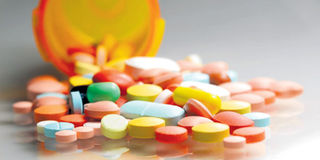Breaking News: At least 10 feared to have drowned in Makueni river
Antibiotics treat terrible diseases but resistance is dangerous

Antibiotics are regarded as the most effective type of antimicrobial agents for fighting bacterial infections. PHOTO | FILE| NATION MEDIA GROUP
What you need to know:
- Resistance occurs when bacteria develop mechanisms to withstand the response of the mode of action of a drug.
Antibiotics are regarded as the most effective type of antimicrobial agents for fighting bacterial infections. Their mode of action is to kill or inhibit the growth of bacteria.
Though some possess antiprotozoal qualities, an antibiotic cannot cure viral infections such as cold flu and influenza.
In ancient Greek, antibiotic means “opposing life”.
Antibiotics are among the most widely used medication by human beings. They are categorised into numerous classes, according to their unique mode of action. Their side-effects are almost similar — such as nausea and vomiting. But their irrational misuse has been a source of concern.
Antibiotic resistance is an emerging global issue. According to the World Health Organisation (WHO), it is one of the biggest threats to global health and can affect a person of any age or race.
Resistance occurs when bacteria develop mechanisms to withstand the response of the mode of action of a drug. It is an evolution through natural selection, causing mutation that is passed as a trait to the offspring of the deviance microbes, hence becoming a fully resistant generation.
INVENT MEDICINES
Besides the efforts of pharmacists and other scientists to invent medicines, there is a need to create awareness in regard to this situation. Prescribers and dispensers of antibiotics must also be aware of the dynamic changes and so include the use of behavioural changes such as vaccination, safe sex and good food hygiene.
Common causes of resistance, include patients not finishing their prescribed antibiotics, over-prescription of antibiotics, prescribed wrong antibiotics for certain infections, poor hygiene and sanitation and poor infection control in a healthcare setup.
Individuals and bodies such as the Kenya Medical Practitioners and Dentists board (KMPDB) and the Pharmacy and Poisons Board of Kenya (PPB), as well as community health officers, ought to create measures and guidelines to curb the trend — lest, soon, diseases that were easily curable and treatable, will become a nightmare to doctors.
DANGEROUS INFECTIONS
This will, eventually, lead to very severe and dangerous infections that no antibiotic can cure, hence acquiring costly medicinal therapy will become too costly, or lead to disability even death.
It is astonishing to find many chemists dispensing half-doses of antibiotics, especially when the patient cannot afford a full dose. This is among the little mistakes medics in the field make in the name of pushing sales, putting the life of millions of people at the risk of antibiotic resistance.
Pharmacists and clinicians should handle patients who prefer empirical therapy as uninformed persons in drug pharmacokinetic and pharmacodynamic.
Medics should up their engagement with patients to improve and control the irrational use of antibiotics. Awareness about the side-effects and the unintended consequences of antibiotics is critical.
Tonny Anene, pharmaceutical technologist, researcher and writer, via email.




